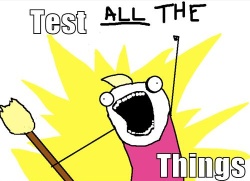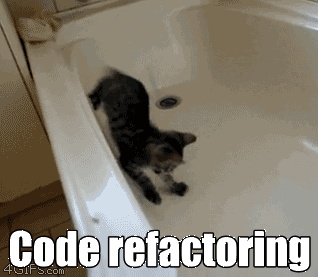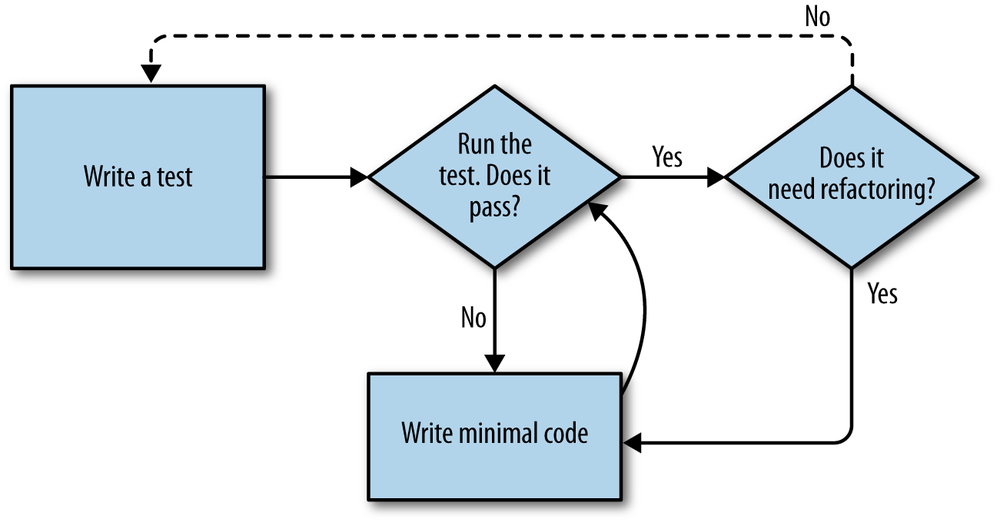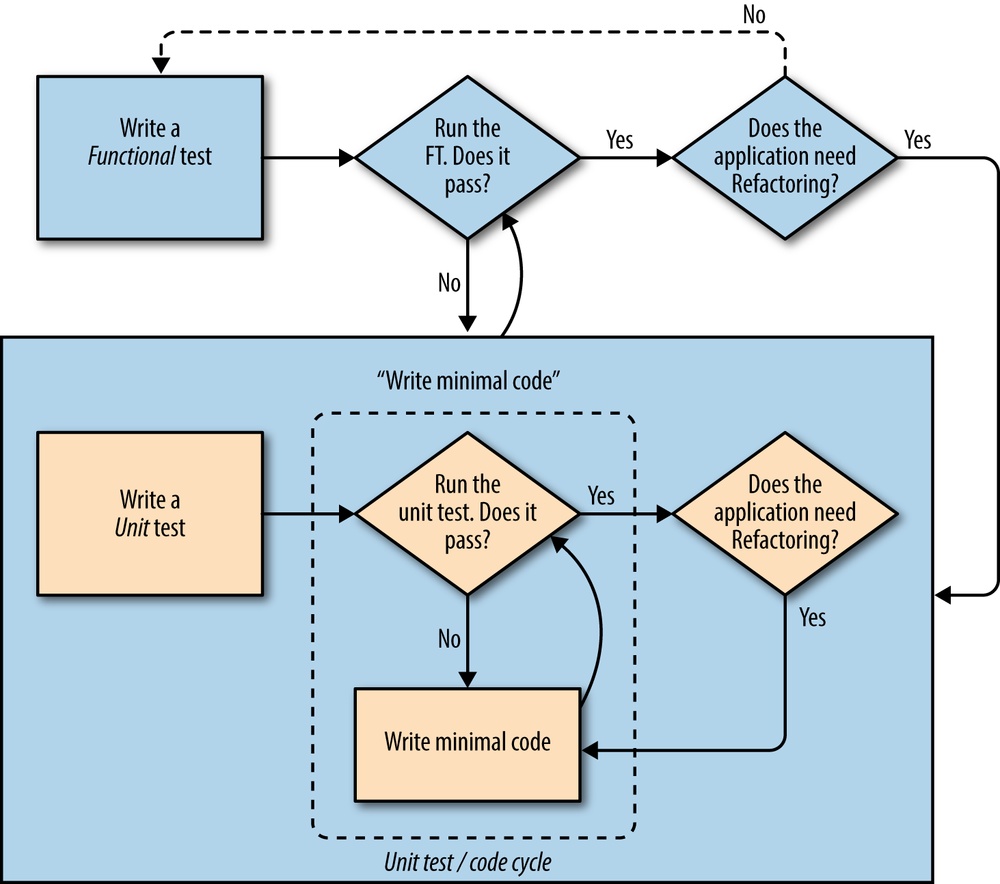Chapter 4. What Are We Doing with All These Tests?
Now that we’ve seen the basics of TDD in action, it’s time to pause and talk about why we’re doing it.
I’m imagining several of you, dear readers, have been holding back some seething frustration—perhaps some of you have done a bit of unit testing before, and perhaps some of you are just in a hurry. You’ve been biting back questions like:
- Aren’t all these tests a bit excessive?
- Surely some of them are redundant? There’s duplication between the functional tests and the unit tests.
-
I mean, what are you doing importing
django.core.urlresolversin your unit tests? Isn’t that testing Django, i.e., testing third-party code? I thought that was a no-no? - Those unit tests seemed way too trivial—testing one line of declaration, and a one-line function that returns a constant! Isn’t that just a waste of time? Shouldn’t we save our tests for more complex things?
-
What about all those tiny changes during the unit-test/code cycle? Surely we
could have just skipped to the end? I mean,
home_page = None!? Really? - You’re not telling me you actually code like this in real life?
Ah, young grasshopper. I too was once full of questions like these. But only because they’re perfectly good questions. In fact, I still ask myself questions like these, all the time. Does all this stuff really have value? Is this a bit of a cargo cult?
Programming Is like Pulling a Bucket of Water up from a Well
Ultimately, programming is hard. Often, we are smart, so we succeed. TDD is there to help us out when we’re not so smart. Kent Beck (who basically invented TDD) uses the metaphor of lifting a bucket of water out of a well with a rope: when the well isn’t too deep, and the bucket isn’t very full, it’s easy. And even lifting a full bucket is pretty easy at first. But after a while, you’re going to get tired. TDD is like having a ratchet that lets you save your progress, take a break, and make sure you never slip backwards. That way you don’t have to be smart all the time.
OK, perhaps in general, you’re prepared to concede that TDD is a good idea, but maybe you still think I’m overdoing it? Testing the tiniest thing, and taking ridiculously many small steps?
TDD is a discipline, and that means it’s not something that comes naturally; because many of the payoffs aren’t immediate but only come in the longer term, you have to force yourself to do it in the moment. That’s what the image of the Testing Goat is supposed to illustrate—you need to be a bit bloody-minded about it.
Now, back to our onions.
Using Selenium to Test User Interactions
Where were we at the end of the last chapter? Let’s rerun the test and find out:
$ python3 functional_tests.py
F
======================================================================
FAIL: test_can_start_a_list_and_retrieve_it_later (__main__.NewVisitorTest)
---------------------------------------------------------------------
Traceback (most recent call last):
File "functional_tests.py", line 20, in
test_can_start_a_list_and_retrieve_it_later
self.fail('Finish the test!')
AssertionError: Finish the test!
---------------------------------------------------------------------
Ran 1 test in 1.609s
FAILED (failures=1)Did you try it, and get an error saying Problem loading page or
Unable to connect? So did I. It’s because we forgot to spin up the dev
server first using manage.py runserver. Do that, and you’ll get the failure
message we’re after.
Note
One of the great things about TDD is that you never have to worry about forgetting what to do next—just rerun your tests and they will tell you what you need to work on.
“Finish the test”, it says, so let’s do just that! Open up functional_tests.py and we’ll extend our FT:
functional_tests.py.
fromseleniumimportwebdriverfromselenium.webdriver.common.keysimportKeysimportunittestclassNewVisitorTest(unittest.TestCase):defsetUp(self):self.browser=webdriver.Firefox()self.browser.implicitly_wait(3)deftearDown(self):self.browser.quit()deftest_can_start_a_list_and_retrieve_it_later(self):# Edith has heard about a cool new online to-do app. She goes# to check out its homepageself.browser.get('http://localhost:8000')# She notices the page title and header mention to-do listsself.assertIn('To-Do',self.browser.title)header_text=self.browser.find_element_by_tag_name('h1').textself.assertIn('To-Do',header_text)# She is invited to enter a to-do item straight awayinputbox=self.browser.find_element_by_id('id_new_item')self.assertEqual(inputbox.get_attribute('placeholder'),'Enter a to-do item')# She types "Buy peacock feathers" into a text box (Edith's hobby# is tying fly-fishing lures)inputbox.send_keys('Buy peacock feathers')# When she hits enter, the page updates, and now the page lists# "1: Buy peacock feathers" as an item in a to-do list tableinputbox.send_keys(Keys.ENTER)table=self.browser.find_element_by_id('id_list_table')rows=table.find_elements_by_tag_name('tr')self.assertTrue(any(row.text=='1: Buy peacock feathers'forrowinrows))# There is still a text box inviting her to add another item. She# enters "Use peacock feathers to make a fly" (Edith is very# methodical)self.fail('Finish the test!')# The page updates again, and now shows both items on her list[...]
We’re using several of the methods that Selenium provides to examine web
pages: find_element_by_tag_name, find_element_by_id, and
find_elements_by_tag_name (notice the extra s, which means it will
return several elements rather than just one). We also use send_keys,
which is Selenium’s way of typing into input elements. You’ll also see the
Keys class (don’t forget to import it), which lets us send special keys
like Enter, but also modifiers like Ctrl.
Tip
Watch out for the difference between the Selenium find_element_by...
and find_elements_by... functions. One returns an element, and raises
an exception if it can’t find it, whereas the other returns a list, which
may be empty.
Also, just look at that any function. It’s a little-known Python built-in.
I don’t even need to explain it, do I? Python is such a joy.
Although, if you’re one of my readers who doesn’t know Python, what’s happening
inside the any is a generator expression, which is like a list
comprehension but awesomer. You need to read up on this. If you Google it,
you’ll find Guido himself explaining it nicely.
Come back and tell me that’s not pure joy!
Let’s see how it gets on:
$ python3 functional_tests.py
[...]
selenium.common.exceptions.NoSuchElementException: Message: Unable to locate
element: {"method":"tag name","selector":"h1"}
Stacktrace:
[...]Decoding that, the test is saying it can’t find an <h1> element on the page.
Let’s see what we can do to add that to the HTML of our home page.
Big changes to a functional test are usually a good thing to commit on their own. I failed to do so in my first draft, and I regretted it later when I changed my mind and had the change mixed up with a bunch of others. The more atomic your commits, the better:
$ git diff # should show changes to functional_tests.py $ git commit -am "Functional test now checks we can input a to-do item"
The “Don’t Test Constants” Rule, and Templates to the Rescue
Let’s take a look at our unit tests, lists/tests.py. Currently we’re looking for specific HTML strings, but that’s not a particularly efficient way of testing HTML. In general, one of the rules of unit testing is Don’t test constants, and testing HTML as text is a lot like testing a constant.
In other words, if you have some code that says:
wibble=3
There’s not much point in a test that says:
frommyprogramimportwibbleassertwibble==3
Unit tests are really about testing logic, flow control, and configuration. Making assertions about exactly what sequence of characters we have in our HTML strings isn’t doing that.
What’s more, mangling raw strings in Python really isn’t a great way of dealing with HTML. There’s a much better solution, which is to use templates. Quite apart from anything else, if we can keep HTML to one side in a file whose name ends in .html, we’ll get better syntax highlighting! There are lots of Python templating frameworks out there, and Django has its own which works very well. Let’s use that.
Refactoring to Use a Template
What we want to do now is make our view function return exactly the same HTML, but just using a different process. That’s a refactor—when we try to improve the code without changing its functionality.
That last bit is really important. If you try and add new functionality at the same time as refactoring, you’re much more likely to run into trouble. Refactoring is actually a whole discipline in itself, and it even has a reference book: Martin Fowler’s Refactoring.
The first rule is that you can’t refactor without tests. Thankfully, we’re doing TDD, so we’re way ahead of the game. Let’s check our tests pass; they will be what makes sure that our refactoring is behaviour preserving:
$ python3 manage.py test
[...]
OKGreat! We’ll start by taking our HTML string and putting it into its own file. Create a directory called lists/templates to keep templates in, and then open a file at lists/templates/home.html, to which we’ll transfer our HTML:[5]
lists/templates/home.html.
<html><title>To-Do lists</title></html>
Mmmh, syntax-highlighted…much nicer! Now to change our view function:
lists/views.py.
fromdjango.shortcutsimportrenderdefhome_page(request):returnrender(request,'home.html')
Instead of building our own HttpResponse, we now use the Django render
function. It takes the request as its first parameter (for reasons we’ll go
into later) and the name of the template to render. Django will automatically
search folders called templates inside any of your apps’ directories. Then
it builds an HttpResponse for you, based on the content of the template.
Note
Templates are a very powerful feature of Django’s, and their main
strength consists of substituting Python variables into HTML text. We’re
not using this feature yet, but we will in future chapters. That’s
why we use render and (later) render_to_ string rather than, say, manually
reading the file from disk with the built-in open.
Let’s see if it works:
$ python3 manage.py test [...] ====================================================================== ERROR: test_home_page_returns_correct_html (lists.tests.HomePageTest)--------------------------------------------------------------------- Traceback (most recent call last): File "/workspace/superlists/lists/tests.py", line 17, in test_home_page_returns_correct_html response = home_page(request)
File "/workspace/superlists/lists/views.py", line 5, in home_page return render(request, 'home.html')
File "/usr/local/lib/python3.3/dist-packages/django/shortcuts.py", line 48, in render return HttpResponse(loader.render_to_string(*args, **kwargs), File "/usr/local/lib/python3.3/dist-packages/django/template/loader.py", line 170, in render_to_string t = get_template(template_name, dirs) File "/usr/local/lib/python3.3/dist-packages/django/template/loader.py", line 144, in get_template template, origin = find_template(template_name, dirs) File "/usr/local/lib/python3.3/dist-packages/django/template/loader.py", line 136, in find_template raise TemplateDoesNotExist(name) django.template.base.TemplateDoesNotExist: home.html
--------------------------------------------------------------------- Ran 2 tests in 0.004s
Another chance to analyse a traceback:

We start with the error: it can’t find the template.

Then we double-check what test is failing: sure enough, it’s our test of the view HTML.

Then we find the line in our tests that caused the failure: it’s when we call the
home_pagefunction.
Finally, we look for the part of our own application code that caused the failure: it’s when we try and call
render.
So why can’t Django find the template? It’s right where it’s supposed to be, in the lists/templates folder.
The thing is that we haven’t yet officially registered our lists app with
Django. Unfortunately, just running the startapp command and
having what is obviously an app in your project folder isn’t quite enough. You
have to tell Django that you really mean it, and add it to settings.py as
well. Belt and braces. Open it up and look for a variable called
INSTALLED_APPS, to which we’ll add lists:
superlists/settings.py.
# Application definitionINSTALLED_APPS=('django.contrib.admin','django.contrib.auth','django.contrib.contenttypes','django.contrib.sessions','django.contrib.messages','django.contrib.staticfiles','lists',)
You can see there’s lots of apps already in there by default. We just need to
add ours, lists, to the bottom of the list. Don’t forget the trailing comma—it may not be required, but one day you’ll be really annoyed when you forget
it and Python concatenates two strings on different lines…
Now we can try running the tests again:
$ python3 manage.py test
[...]
self.assertTrue(response.content.endswith(b'</html>'))
AssertionError: False is not trueDarn, not quite.
Note
Depending on whether your text editor insists on adding newlines to the end of files, you may not even see this error. If so, you can safely ignore the next bit, and skip straight to where you can see the listing says OK.
But it did get further! It seems it’s managed to find our template, but
the last of the three assertions is failing. Apparently there’s something wrong
at the end of the output. I had to do a little print(repr(response.content))
to debug this, but it turns out that the switch to templates has introduced an
additional newline (\n) at the end. We can get them to pass like this:
lists/tests.py.
self.assertTrue(response.content.strip().endswith(b'</html>'))
It’s a tiny bit of a cheat, but whitespace at the end of an HTML file really shouldn’t matter to us. Let’s try running the tests again:
$ python3 manage.py test
[...]
OKOur refactor of the code is now complete, and the tests mean we’re happy that
behaviour is preserved. Now we can change the tests so that they’re no longer
testing constants; instead, they should just check that we’re rendering the
right template. Another Django helper function called render_to_string is
our friend here:
lists/tests.py.
fromdjango.template.loaderimportrender_to_string[...]deftest_home_page_returns_correct_html(self):request=HttpRequest()response=home_page(request)expected_html=render_to_string('home.html')self.assertEqual(response.content.decode(),expected_html)
We use .decode() to convert the response.content bytes into a Python
unicode string, which allows us to compare strings with strings, instead
of bytes with bytes as we did earlier.
The main point, though, is that instead of testing constants we’re testing our implementation. Great!
Note
Django has a test client with tools for testing templates, which we’ll use in later chapters. For now we’ll use the low-level tools to make sure we’re comfortable with how everything works. No magic!
On Refactoring
That was an absolutely trivial example of refactoring. But, as Kent Beck puts it in Test-Driven Development: By Example, “Am I recommending that you actually work this way? No. I’m recommending that you be able to work this way.”
In fact, as I was writing this my first instinct was to dive in and change the
test first—make it use the render_to_string function straight away,
delete the three superfluous assertions, leaving just a check of the contents
against the expected render, and then go ahead and make the code change. But
notice how that actually would have left space for me to break things: I could
have defined the template as containing any arbitrary string, instead of
the string with the right <html> and <title> tags.
Tip
When refactoring, work on either the code or the tests, but not both at once.
There’s always a tendency to skip ahead a couple of steps, to make a couple of tweaks to the behaviour while you’re refactoring, but pretty soon you’ve got changes to half a dozen different files, you’ve totally lost track of where you are, and nothing works any more. If you don’t want to end up like Refactoring Cat (Figure 4-2), stick to small steps; keep refactoring and functionality changes entirely separate.
Note
We’ll come across “Refactoring Cat” again during this book, as an example of what happens when we get carried away and want to change too many things at once. Think of it as the little cartoon demon counterpart to the Testing Goat, popping up over your other shoulder and giving you bad advice…
It’s a good idea to do a commit after any refactoring:
$ git status # see tests.py, views.py, settings.py, + new templates folder $ git add . # will also add the untracked templates folder $ git diff --staged # review the changes we're about to commit $ git commit -m "Refactor home page view to use a template"
A Little More of Our Front Page
In the meantime, our functional test is still failing. Let’s now make an
actual code change to get it passing. Because our HTML is now in a template,
we can feel free to make changes to it, without needing to write any extra unit
tests. We wanted an <h1>:
lists/templates/home.html.
<html><head><title>To-Do lists</title></head><body><h1>Your To-Do list</h1></body></html>
Let’s see if our functional test likes it a little better:
selenium.common.exceptions.NoSuchElementException: Message: Unable to locate
element: {"method":"id","selector":"id_new_item"}OK…
lists/templates/home.html.
[...]
<h1>Your To-Do list</h1>
<input id="id_new_item" />
</body>
[...]
And now?
AssertionError: '' != 'Enter a to-do item'
We add our placeholder text…
lists/templates/home.html.
<inputid="id_new_item"placeholder="Enter a to-do item"/>
Which gives:
selenium.common.exceptions.NoSuchElementException: Message: Unable to locate
element: {"method":"id","selector":"id_list_table"}So we can go ahead and put the table onto the page. At this stage it’ll just be empty…
lists/templates/home.html.
<inputid="id_new_item"placeholder="Enter a to-do item"/><tableid="id_list_table"></table></body>
Now what does the FT say?
File "functional_tests.py", line 42, in
test_can_start_a_list_and_retrieve_it_later
any(row.text == '1: Buy peacock feathers' for row in rows)
AssertionError: False is not true
Slightly cryptic. We can use the line number to track it down, and it turns out
it’s that any function I was so smug about earlier—or, more precisely, the
assertTrue, which doesn’t have a very explicit failure message. We can pass
a custom error message as an argument to most assertX methods in unittest:
functional_tests.py.
self.assertTrue(any(row.text=='1: Buy peacock feathers'forrowinrows),"New to-do item did not appear in table")
If you run the FT again, you should see our message:
AssertionError: False is not true : New to-do item did not appear in table
But now, to get this to pass, we will need to actually process the user’s form submission. And that’s a topic for the next chapter.
For now let’s do a commit:
$ git diff $ git commit -am "Front page HTML now generated from a template"
Thanks to a bit of refactoring, we’ve got our view set up to render a template, we’ve stopped testing constants, and we’re now well placed to start processing user input.
Recap: The TDD Process
We’ve now seen all the main aspects of the TDD process, in practice:
- Functional tests
- Unit tests
- The unit-test/code cycle
- Refactoring
It’s time for a little recap, and perhaps even some flowcharts. Forgive me, years misspent as a management consultant have ruined me. On the plus side, it will feature recursion.
What is the overall TDD process? See Figure 4-3.
We write a test. We run the test and see it fail. We write some minimal code to get it a little further. We rerun the test and repeat until it passes. Then, optionally, we might refactor our code, using our tests to make sure we don’t break anything.
But how does this apply when we have functional tests and unit tests? Well, you can think of the functional test as being a high-level view of the cycle, where “writing the code” to get the functional tests to pass actually involves using another, smaller TDD cycle which uses unit tests. See Figure 4-4.
We write a functional test and see it fail. Then, the process of “writing code” to get it to pass is a mini-TDD cycle of its own: we write one or more unit tests, and go into the unit-test/code cycle until the unit tests pass. Then, we go back to our FT to check that it gets a little further, and we can write a bit more of our application—using more unit tests, and so on.
What about refactoring, in the context of functional tests? Well, that means we use the functional test to check that we’ve preserved the behaviour of our application, but we can change or add and remove unit tests, and use a unit test cycle to actually change the implementation.
The functional tests are the ultimate judge of whether your application works or not. The unit tests are a tool to help you along the way.
This way of looking at things is sometimes called “Double-Loop TDD”. One of my eminent tech reviewers, Emily Bache, wrote a blog post on the topic, which I recommend for a different perspective.
We’ll explore all of the different parts of this workflow in more detail over the coming chapters.
[5] Some people like to use another subfolder named after the app (i.e., lists/templates/lists) and then refer to the template as lists/home.html. This is called “template namespacing”. I figured it was overcomplicated for this small project, but it may be worth it on larger projects. There’s more in the Django tutorial.
[6] I don’t recommend skipping ahead. I haven’t designed the chapters to stand on their own; each relies on the previous ones, so it may be more confusing than anything else…
Get Test-Driven Development with Python now with the O’Reilly learning platform.
O’Reilly members experience books, live events, courses curated by job role, and more from O’Reilly and nearly 200 top publishers.





